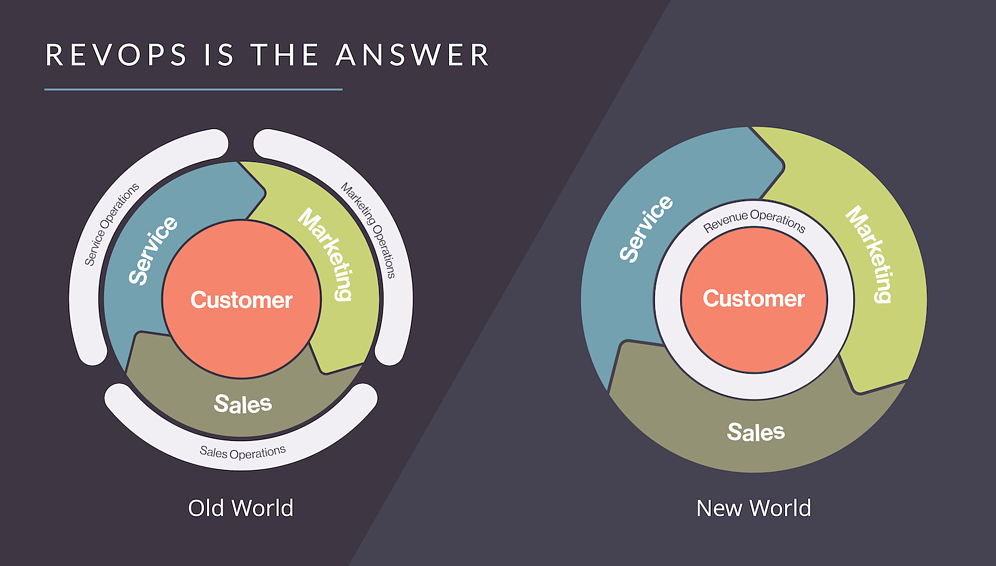I'm sure you've heard the term RevOps or Revenue Operations. The popularity of RevOps has increased dramatically in recent months. We owe this phenomenon to the need to change the standard for the business operational model.
RevOps definition:
Revenue Operations (colloquially, RevOps) is a method for scaling your business, which improves communication between marketing, sales, and customer service/success departments based on smooth data flow, in-depth analysis, and modern technology focusing on automation.
By 2025, 75% of the highest growth companies in the world will deploy a Revenue Operations (RevOps) model.
(Source: Gartner 2021)
What is the structure of RevOps?
Well, the old operating model focuses on improving the operations of separate departments in business, such as marketing, sales, and customer service. While this old method allows you to focus 100% on a specific area, unfortunately, it is insufficient for business scaling. Why? Because the lack of cooperation/communication between departments limits the data flow, and therefore we cannot gain precise insight into high-level business operations. This, in turn, blocks us from accurate data analytics on the basis of which we can make decisions about improving and scaling our company, ultimately trying to minimize costs and increase revenue.
Ask yourself the following questions:
- How well your entire team communicates?
- How seamless is the buyer's journey of your clients?
- Are your processes efficient or time-consuming?
- Are you using automation and technology to your advantage?
These questions are intended to give you a better understanding of what problems RevOps can solve. Mary Barba, an Inbound Marketing at HubSpot, translates RevOps as "the people, processes, systems, and data that control how a company generates revenue."
Companies that align the people, processes, and technology will experience 36% more revenue growth and up to 28% more profitability.
(Source: Forrester 2021)
What are the benefits of RevOps?
Besides revenue generation, the implementation of the RevOps model has the following benefits:
Increased efficiency of resources.
Let's imagine a situation that we've all been in. We are in the conference room, listening to the end-of-quarter presentations from marketing, sales, and customer success. The marketing manager tells about the number of page views and the number of obtained leads; the sales lead presents the number of closed deals; and the customer success rep presents the customer retention rate. All those are specialists in their field and present data that they think is valuable to them, however, no one really knows what this data has in common. With poor results, teams most often blame each other, e.g. marketing blames sales for not working with their leads, while sales is saying that the leads given by marketing are a bust, etc.
This is an example of a team that is inefficient and not focused on the main goal of a company (which let's face it is revenue generation) together as a team, not a separate department. RevOps prevents this from happening by mapping and matching the transfer points of our leads (or customers) between all departments, taking into account the entire customer journey.
By implementing the RevOps model, companies can remove blockages and silos between departments, increasing the efficiency of the entire company. Constant communication between the marketing, sales, and customer service teams enables visibility of how certain activities of individual departments affect the activities of other departments. This takes us to the next point:
Improving business decisions based on real data.
Why is the transparency of activities across all departments so important? Because when there is no strategic communication between departments, often a lot of important data disappears. Data silos are one of the biggest concerns of a growing company - so RevOps approaches all data in a unified way that gives a holistic view of not only what the data is but also how it affects revenue. RevOps creates a shared reality in terms of metrics, definitions, and goals - providing seamless and in-depth analytics from a single, shared truth source.
Why is a single, shared source of truth in data analytics so valuable? Well, we can make better business decisions based on real data and we can take control of our processes wisely because we have an insight into how certain actions affect the results. And RevOps helps us find key data points that influence the set of activities.

According to the research conducted by the Boston Consulting Group (2020), RevOps results in:
- Increased lead acceptance
- Improving ROI in marketing;
- Increase in customer satisfaction.
To summarize, RevOps is a method that aims to generate revenue by unifying teams of people, processes, systems, and data. With RevOps, you will be able to increase the efficiency of your team and resources, and improve decision-making based on real data.
This blog post is part of ClickRay's RevOps series. Do you want to gain insight into how to successfully implement a RevOps strategy that drives meaningful results of revenue growth? Read more of our articles:
|
A Guide to a Successful Revenue Operations Strategy
|





